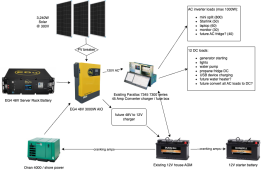Hi everyone, I've read all I could over the last few months and I'm seeking advice on my proposed system diagram before I order and install all my components in the next month. Please give me your thoughts.
The basics:

Version 1 plan:
Future ideas for efficiency:
Please let me know if there's anything wrong with this plan to start, you'd strongly suggest different hardware (like Growatt + SOK instead of EG4), or any other insights you might have. Thanks!
The basics:
- 30 foot class C toy hauler, meaning the living area is quite small (8’ x 16’)
- I will be living, working, and riding dirt bikes out of this vehicle for a few months at a time
- I’ll be using this in some desert climates, so outdoor daytime temperatures may exceed 100F
- I’ll also be using this in some mountain climates, when the temperatures are just above freezing
- I can generally park in full sun with no obstructions
- Main power requirement will be mini split, secondary will be laptop + monitor + Starlink, no slide outs (biggest 12V draw is starting generator)
- More concerned with simplicity of DIY build than money or pure efficiency in version 1. Just gotta get on the road and see what doesn’t work before premature optimization.

Version 1 plan:
- 3300W of solar on elevated roof rack (6 x 540W panels at 49 VOC, in 6S configuration for 297V PV @ 13.72A ISC)
- Add panels, EG4 300W 48V AIO, and one EG4 48V 5120Wh server rack battery
- Leave existing 12V AGM house battery in place to start generator or starter battery in emergencies
- Wire the output of the AIO into the existing breaker panel to provide 120V (and wire the shore power/generator output cable into the input of the AIO)
- Let the existing Parallax 7300 Series 7345 Converter in the breaker panel provide 12V and keep the house battery full
- Consider accepting the inefficiency of both the AIO idle draw and the PV -> 120V -> 12V conversion for the 12V system and house battery
Future ideas for efficiency:
- Just add a second server rack battery and don’t worry about efficiency at all forever
- Add Chinese diesel heater if overnight winter heat requirements can’t be met with solar and two batteries
- Add 48V to 12V battery charger (cannot find one from a reliable manufacturer, the Victrons are only converters, not chargers)
- Go Victron with separate components to reduce AIO idle draw
- Convert fridge to either AC or DC
- Current propane fridge is dying, and if I have to leave the inverter on most of the time for the mini split, why not just run the fridge off AC?
- Convert everything to DC
- Mini split, fridge, Starlink, laptop, monitor, can all be converted to DC
Please let me know if there's anything wrong with this plan to start, you'd strongly suggest different hardware (like Growatt + SOK instead of EG4), or any other insights you might have. Thanks!



